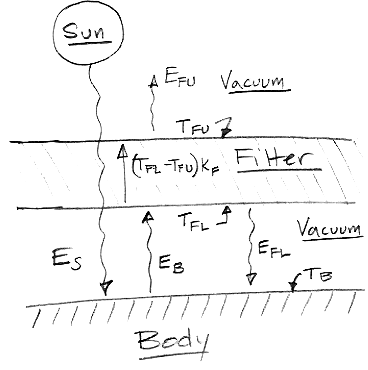The filter is so-called because it allows short-wave radiation to pass through without loss, but absorbs all long-wave radiation immediately upon entering. By radiative symmetry, the filter cannot radiate at all at short wavelengths, but is a perfect radiator of long wavelengths. The body itself we assume is a perfect absorber of short-wave radiation and a perfect emitter of long-wave radiation. Which is to say: it is black to both short-wave and long-wave radiation.

The squiggly lines are radiation, denoted E with an appropriate subscript: S for sun, B for body, FL for filter lower surface, and FU for filter upper surface. We measure radiation in units of W/m2. We have temperatures marked also, denoted T. There is heat flow by conduction within the filter, amounting to KF(TFL−TFU), where F is the conductivity of the filter in W/Km2. The only heat flow from the body to the filter is by radiation, because the two are separated by a vacuum.
We assume that all parts of our system are in thermal equilibrium, which is to say that their temperature is constant, so that there is as much heat leaving them as entering them. We assume there is no way for heat to leave the body except through its top surface, which would be the case if the top surface wrapped around upon itself as does the surface of a sphere.
Let's start with the simple case where the filter is a perfect conductor, so that TFL = TFU (KF is infinite). The top and bottom surfaces are black-body radiators, so they both emit the same amount of long-wave radiation. Thus EFL = EFU. Meanwhile, we must have as much heat leaving our system as entering, so ES = EFU. At the same time, we must have equal heat entering and leaving the body itself, so ES + EFL = 2EFL = EB. The power radiated by the body is a factor of two greater than the power arriving from the sun.
Radiated power is related to temperature by Stefan's Law. With σ as Stefan's constant, we have EB = σ(TB)4 = 2EFL = σ(TFL)4, from which we conclude TB = 21/4TFL = 1.19TFL. But TFL = TFU, and we can determine TFU by noting that ES = EFU = σ(TFU)4, which yields TFU = (ES/σ)1/4. As we showed in Solar Heat, in the case of the Sun and the Earth, we have ES = 350 W/m2. With 350 W/m2 arriving from the sun, we would have, in our example construction, TFU = 280 K = 7°C and TB = 333 K = 60°C. The presence of the filter raises the temperature of our body by 53°C.
The greenhouse heating of a black body when we place a perfectly-conducting greenhouse filter between the body and a source of short-wave radiation is 19% of its equilibrium absolute temperature without the filter. Furthermore, in these particular circumstances, the heat radiated by the warmed body is exactly twice that radiated into space by the filter, and twice that received from the source of short-wave radiation.

Hi Kevan,
ReplyDeleteInteresting, although still a long way from a rotating earth with night and day regimes.
You have (thermal) conductivity as W/Km2; should it not be W/Km (or Wm-1K-1)?
Hugh
Dear Hugh, Yes, it's still a long way to go. But I'm getting there in small steps. I think I have used conductivity correctly. What you are referring to is the "specific conductivity", which is a property of the material. The "conductivity" is a property of a particular object. Of course, in speech and often in writing, we abbreviate "specific conductivity" to "conductivity".
ReplyDelete